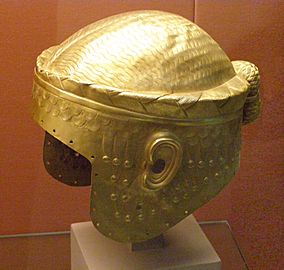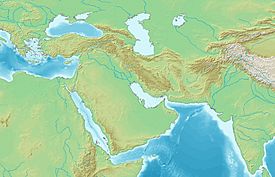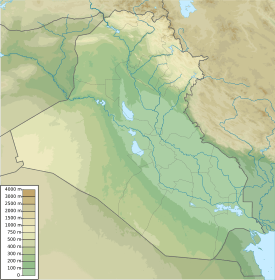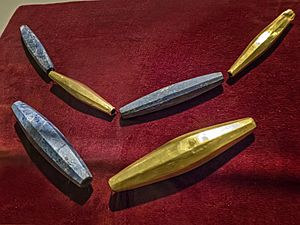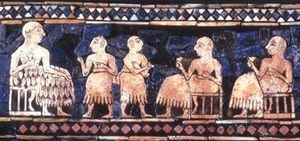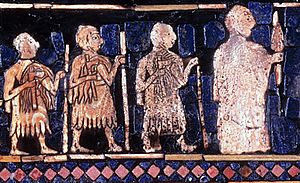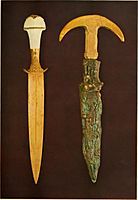First Dynasty of Ur facts for kids
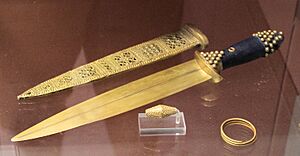
The First Dynasty of Ur was a group of rulers from the ancient city of Ur in Sumer. This dynasty existed between 2600 and 2500 BCE. It was an important part of the Early Dynastic period III in the history of Mesopotamia. Before Ur, other powerful cities like Kish and Uruk had their own ruling families.
Contents
Rulers of Ancient Ur
According to an old text called the Sumerian King List, a ruler named Mesannepada from Ur took power. He defeated Lugal-kitun, the last king of Uruk. The Sumerian King List names four kings from Ur: Mesannepada, Mes-kiagnuna, Elulu, and Balulu.
However, other ancient records mention two earlier kings: Meskalamdug and A-Kalam-du. It seems Meskalamdug might have been the first ruler of this dynasty. Mesannepada was likely his son. We also know about a queen named Puabi from her very rich tomb. The First Dynasty of Ur became very powerful. It united many cities in southern Mesopotamia.
Who Lived in Ur?
The people of Ur were Sumerians. They were not Semitic people, who spoke different languages. Sumerians might have come from the east around 3300 BCE. They spoke a unique language that isn't related to any other known language. This is called a language isolate.
Later, around 2270 BCE, the Semitic-speaking kings of the Akkadian Empire took over Sumer. Even then, the Sumerian language was still used for religious purposes. Sumerian rule returned for about 100 years with the Third Dynasty of Ur. This was around 2100–2000 BCE, but the Akkadian language also remained in use.
Ur's Global Trade
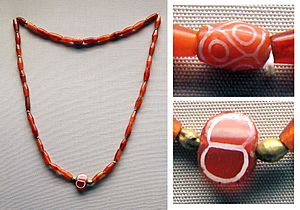
The treasures found in the royal tombs of Ur show how much trade happened back then. Many valuable materials came from far-off lands. For example, Carnelian stones probably came from the Indus Valley or Iran. Lapis lazuli came from the Badakhshan area in Afghanistan. Silver came from Turkey, copper from Oman, and gold from places like Egypt, Nubia, Turkey, or Iran.
Carnelian beads with special etched designs were found in Ur's tombs. These beads, dating from 2600-2450 BCE, were probably imported from the Indus Valley. They were made using a special technique developed by the Harappan people. All these materials were used to create amazing objects in Ur's workshops.
The First Dynasty of Ur was incredibly wealthy. This wealth is clear from the luxurious tombs discovered. Ur was likely a major port for trade with India. This gave Ur a great position to import and sell large amounts of gold, carnelian, and lapis lazuli. In comparison, the tombs of kings from Kish were much less grand. It's thought that Sumerian ships with high prows might have traveled as far as Meluhha, which is believed to be the Indus region, for trade.
The End of the Dynasty
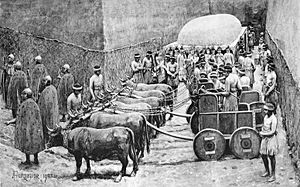
The Sumerian King List tells us that the First Dynasty of Ur was eventually defeated. Power then shifted to the Elamite Awan dynasty. Later, a Sumerian king named Eannatum from Lagash (around 2500–2400 BCE) took control of the whole region. He created one of the first known empires in history.
Ur's power would only rise again centuries later with the Third Dynasty of Ur.
The Sumerian King List
The Sumerian King List is an ancient document that lists kings of Sumer. It tells us about the rulers and how long they reigned. Only the later kings of the First Dynasty of Ur are mentioned in this list. These include Mesannepada, Mesh-ki-ang-Nanna, Elulu, and Balulu.
The list says:
"... Uruk was defeated in battle, and the kingship was moved to Ur. In Ur, Mesannepada was king and ruled for 80 years. Mesh-ki-ang-Nanna, son of Mesannepada, was king and ruled for 36 years. Elulu ruled for 25 years. Balulu ruled for 36 years. Four kings ruled for a total of 171 years. Ur was defeated in battle; the kingship was moved to Awan."
—Sumerian King List, 137-147.
Amazing Artifacts from Ur
The Royal Cemetery of Ur is where many tombs of the First Dynasty of Ur's rulers were found. These tombs were incredibly rich and full of treasures. They show just how wealthy the First Dynasty of Ur was. One of the most famous tombs belongs to Queen Puabi.
-
Reconstructed Sumerian headgear and necklaces from Queen Puabi's tomb.
-
Cylinder seal of Queen Puabi, found in her tomb.
-
A bull's head from Queen Puabi's lyre.
See also
 In Spanish: Primera dinastía de Ur para niños
In Spanish: Primera dinastía de Ur para niños


